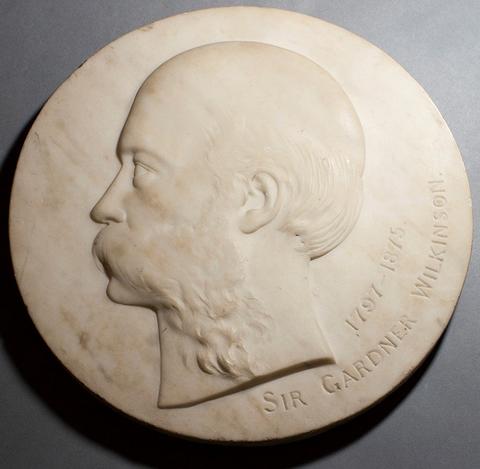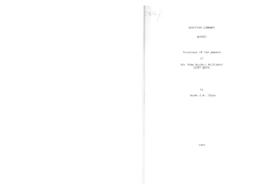
Identity area
Reference code
Wilkinson J. G. MSS
Title
Date(s)
Level of description
Collection
Extent and medium
Context area
Name of creator
Biographical history
British Egyptologist and traveller; he was probably born in Little Missenden, Bucks, 5 Oct 1797, son of the Revd John W. and Mary Anne Gardner; Wilkinson may be regarded as the real founder of Egyptology in Great Britain; he was educated at Harrow, 1813-16, where he came under the influence of the head master, George Butler who was a friend of Thomas Young and an erstwhile student of his in the decipherment of Egyptian hieroglyphs; he entered Exeter College, Oxford, 1816, but left in 1818 without taking a degree; he embarked on a tour of Europe and Egypt in 1819 prior to joining the army, visiting Italy in 1820 where he met Sir William Gell who first persuaded him to abandon his intended army career and devote his life to the study of Egyptian and other archaeology; possessed of a small income, Wilkinson was able to take up the study of Egyptian hieroglyphic writing as yet incompletely deciphered and not properly understood, and went to Egypt in 1821, where he remained for no fewer than 12 years continuously, except for visits to Nubia and the surrounding deserts; he journeyed as far south as the Second Cataract twice, and carried out excavations at Thebes in 1824, 1827-8; he worked mainly among the tombs as he did not have the resources to engage in greater works; while in Egypt he also studied Arabic and Coptic, learning the latter like Champollion so that it might help him in his work of deciphering inscriptions which he accomplished by dint of hard work and the study of all the material available but also by using and at times correcting his results; there was at this date probably nobody else capable of doing this; after gathering an immense amount of material Wilkinson returned to England, 1833; he was made FRS, 1834; knighted, 1839; DCL, Oxford University, 1852; he revisited Egypt in 1841-2 and surveyed the Natron lakes, publishing an account of his travels, 1843; in 1843-4 he made a great survey of Montenegro, Herzegovina, and Bosnia and published an account of this expedition in two vols.; he visited Egypt again in 1843 and 1848-9, and spent the following winter in Italy, 1849-50; here he studied the Turin Canon of Kings more thoroughly than it had ever been done before, and published a new facsimile; he visited Egypt for the last time, 1855-6; in 1856 he married Caroline Catherine Lucas, a botanist and authoress; he was the first to recognize correctly many royal names and to sort out and put into a reasonable chronological order the dynasties and kings of Egypt; the first to make an adequate working survey of all the main sites in Egypt and Nubia from an archaeological and historical point of view, which he did single-handed unlike the teams who made the French general survey or who assisted Champollion and Lepsius afterwards; the first to draw up a comprehensive plan of ancient Thebes; he preceded both Champollion and Rosellini at Beni Hasan where he made very exact drawings of paintings in the tombs, and where, as at El-Amarna and many other sites throughout Egypt, he noted important archaeological and historical material before other Egyptologists; he was also among the first to identify the site of the Labyrinth at Hawara and many other similar sites; most of his material has never been made available to scholars in adequate form unlike that gathered by Lepsius and other officially sponsored expeditions; he took a prominent part in all archaeological movements in his day and occupied a position in Egyptology analogous to Rawlinson in Assyrian archaeology; he collected natural history specimens, on which he made many important contributions to zoological and geological journals; he was a considerable benefactor to the British Museum, to which he presented many antiquities including articles of furniture and smaller objects connected with daily life such as bread and tools in 1834; these were from tombs and were acquired or excavated by him during his early years in Egypt; he also gave two large collections of papyri (mostly Demotic) in 1834 and 1835; in order to interest young people in the subject he gave his own large collection of classical and Egyptian antiquities to Harrow School, a catalogue of which was published by Budge, 1887; unlike other great Egyptologists such as Champollion and Lepsius, Wilkinson received no government aid for his researches and had to accomplish his vast work on his own; his range of interests far exceeded that of most other Egyptologists before or since; in his monumental account of Egyptian manners and customs he covered, and, although not an expert in all of them, adequately dealt with, over fifty basic subjects, ranging from daily life to chronology, and from botany, astronomy, and geology to funerary beliefs; this work with his survey of modern Egypt and Thebes comprehended in about 2,700 pages the greatest review of ancient Egyptian civilization ever undertaken; during his lifetime Wilkinson was loaded with more honours than any other Egyptologist. His principal publications were Materia Hieroglyphica. Containing the Egyptian pantheon and the succession of the Pharaohs, from the earliest Times to the Conquest by Alexander, and other Hieroglyphical Subjects, 2 vols., 1828-30; Topography of Thebes, and general view of Egypt. Being a short account of the principal objects worthy of notice in the Valley of the Nile, to the Second Cataract and Wadee Samneh, with the Fayoom, Oases, and Eastern Desert from Sooez to Berenice: with remarks on the Manners and Customs of the ancient Egyptians and the productions of the country etc., 1835; Manners and Customs of the Ancient Egyptians. Including their Private Life, Government, Laws, Arts, Manufactures, Religion, Agriculture, and Early History, derived from a comparison of the painting, sculptures, and monuments still existing, with the accounts of ancient authors, 3 vols., 1837, a number of subsequent eds., of which that revised and corrected by Samuel Birch, 3 vols. 1878 is the most popular; Modern Egypt and Thebes. Being a description of Egypt, including the information required for travellers in that Country, 2 vols., 1843; A Handbook for Egypt. Including descriptions of the course of the Nile to the Second Cataract, Alexandria, Cairo, The Pyramids, and Thebes, the overland transit to India, the Peninsula of Mount Sinai, the Oases, etc., a new and shorter ed. of the previous work, and one which became Murray's standard guide for travellers, 1847, among others.
Archival history
Immediate source of acquisition or transfer
Content and structure area
Scope and content
Journal 1841-1842 and some correspondence.
Appraisal, destruction and scheduling
Accruals
System of arrangement
Conditions of access and use area
Conditions governing access
Conditions governing reproduction
Language of material
Script of material
Language and script notes
Physical characteristics and technical requirements
Finding aids
Allied materials area
Existence and location of originals
Existence and location of copies
Related units of description
Notes area
Note
Except for the items mentioned immediately above, the papers of Sir John Gardner Wilkinson are housed in the Weston Library, Department of Special Collections and Western Manuscripts, Bodleian Library, University of Oxford. Please refer to this webpage to download the forms you might have to fill in in order to consult this material: https://www.bodleian.ox.ac.uk/special-collections. To consult the catalogue for the Wilkinson papers held by the Bodleian Library, please see: https://archives.bodleian.ox.ac.uk/repositories/2/resources/3289.
Alternative identifier(s)
Access points
Subject access points
Place access points
Name access points
Genre access points
Description control area
Description identifier
Institution identifier
Rules and/or conventions used
Status
Level of detail
Dates of creation revision deletion
Language(s)
Script(s)
Sources
Digital object metadata
Filename
Wilkinson_Tondo_res72ppi.jpg
Latitude
Longitude
Media type
Image
Mime-type
image/jpeg
